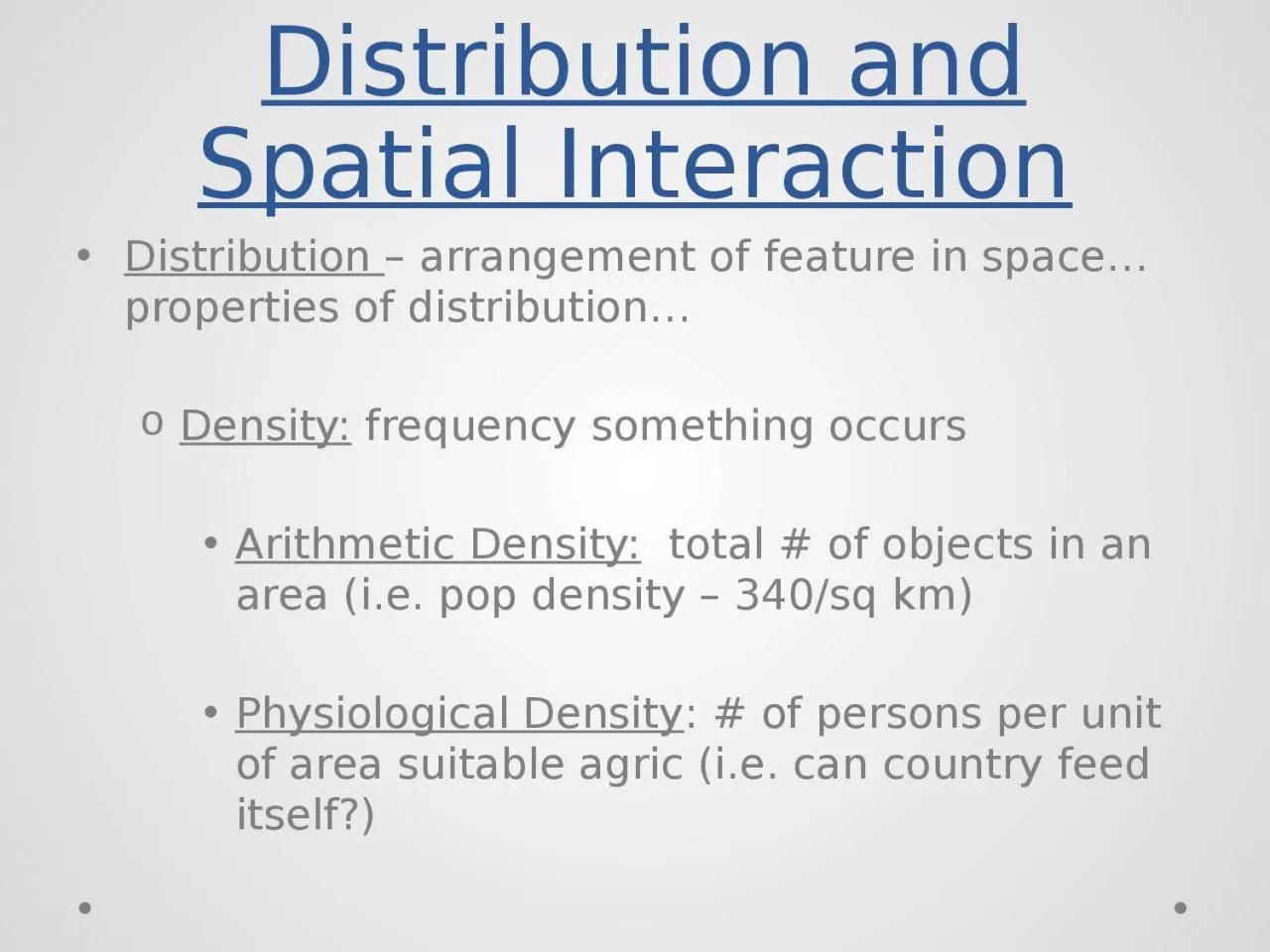

Distribution arrangement of feature in spaceproperties of distribution Density frequency something occurs Arithmetic Density total of objects in an area ie pop density 340sq km ID: 1026054
Download Presentation The PPT/PDF document "Distribution and Spatial Interaction" is the property of its rightful owner. Permission is granted to download and print the materials on this web site for personal, non-commercial use only, and to display it on your personal computer provided you do not modify the materials and that you retain all copyright notices contained in the materials. By downloading content from our website, you accept the terms of this agreement.
1. Distribution and Spatial InteractionDistribution – arrangement of feature in space…properties of distribution…Density: frequency something occursArithmetic Density: total # of objects in an area (i.e. pop density – 340/sq km)Physiological Density: # of persons per unit of area suitable agric (i.e. can country feed itself?)
2. World Population Density
3. US Population Density
4. Distribution (cont’d.)Concentration: feature’s spread over spaceClustered/agglomerated: objects close togetherDispersed/scattered: objects far apart (see next slide)Pattern: geometric arrangement of objects in space (square, rectangle, irregular, etc.)
5. Density and Concentration of Baseball Teams, 1952–2000The changing distribution of North American baseball teamsillustrates the differences between density and concentration.
6. Time Space ConvergenceTime-space convergenceThe rate at which places move closer together in travel or communication costsResults from a decrease in the friction of distance as space-adjusting technologies have brought places closer together over timeGlobal and localShrinking of space has important implications
7. Time-Space ConvergenceFriction of distance – Tobler’s 1st Law of Geog: everything is related to everything else, but nearer things are more related than distant things (i.e. distance itself hinders interaction). Leads to distance decay: contact between two places decreases as distance increases
8. DiscussHow much is Distance Decay an issue today? Is this something geographers might have to re-think?Quick Write: Think about where people are spaced in the US. Where are they clustered? Why there? Where is it dispersed? Why?
9. Space-Time Compression 1492–1962 The times required to cross the Atlantic, or orbit the Earth, illustrate how transport improvements have shrunk the world.
10. Spatial InteractionComplementarity: we need each other Ex. One area needs houses, other area has the trees for lumberTransferability: cost involved in moving goods from one place to anotherCostAbility to bear the costsVariabilitySpace-Time Compression (see next slide)Accessibility: is location accessible? Highways, RR, shipping? Ex: food very expensive in Alaska
11. DIFFUSION Process in which phenomenon (disease, trends, technology, etc.) spread from one place to another over timeHearth: place of originationDiff happens quickly today w/ modern technology, communication, transportationThe “S” Curve
12.
13. Types of Diffusion1.) Relocation Diff: spread b/c people moveLanguages, Money, Aids2.) Expansion Diff: snowball processA. Hierarchical diff: top down processFashion, MusicB. Contagious diff: like a wave without regard to hierarchyDiseases, FadsC. Stimulus diff: spread of underlying principle, even though characteristic itself failed to diffuseSettlers in America – tobacco growers
14.
15. Hierarchical Diffusion
16. Contagious Diffusion
17. Hierarchical and Contagious
18. Stimulus Diffusion
19. Diff of Culture and EconomyMDC to LDC….dominated by N. America, W. Europe, Japan3 major world cities: NYC, London, Tokyo – key decision makers in many businesses around the globeLDCs in Africa, Asia, LA contain ¾ world population and nearly all of its pop growth, but more and more are on periphery of global investment (core/periphery)Result: uneven development…great disparity